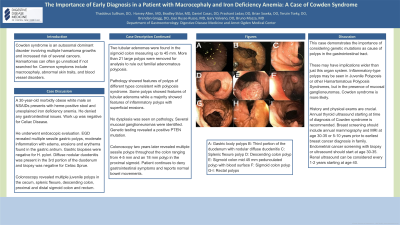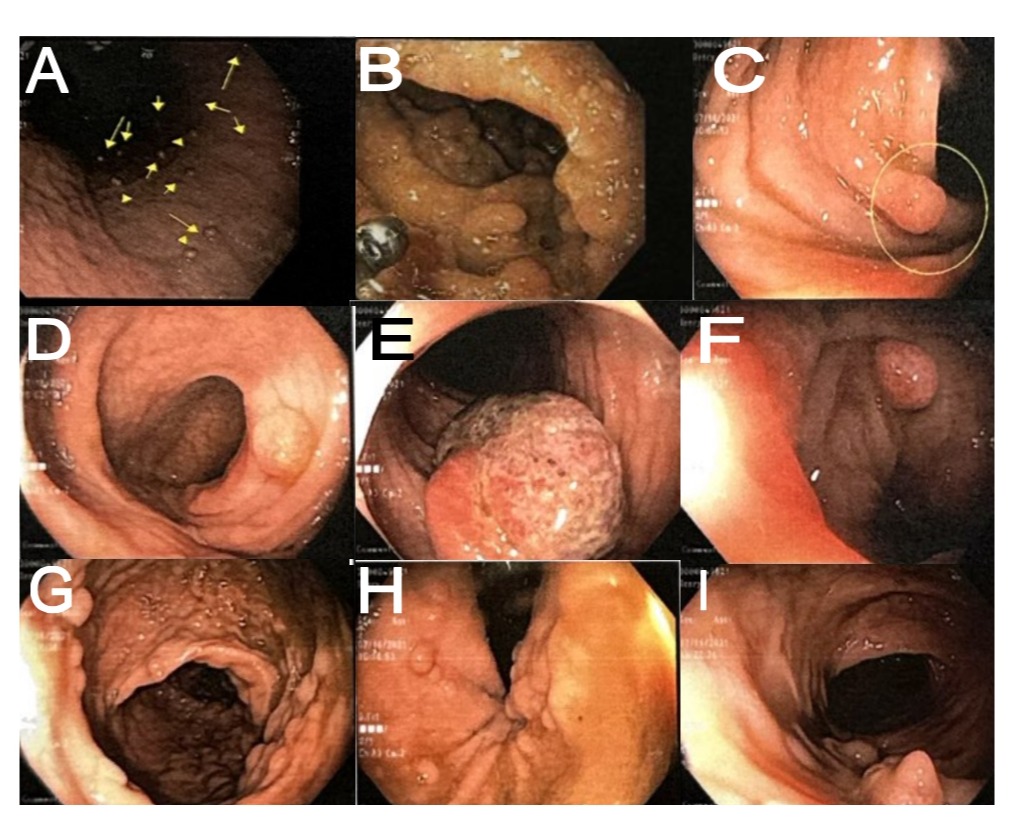Sunday Poster Session
Category: Colon
P0384 - The Importance of Early Diagnosis in a Patient With Macrocephaly and Iron Deficiency Anemia: A Case of Cowden Syndrome
Sunday, October 27, 2024
3:30 PM - 7:00 PM ET
Location: Exhibit Hall E

Has Audio

Thaddeus Sullivan, DO
Arnot Ogden Medical Center
Clinton, NY
Presenting Author(s)
Thaddeus Sullivan, DO1, Bradley Sklar, MD2, Tenzin Tseky, DO3, Gary Valvano, DO3
1Arnot Ogden Medical Center, Clinton, NY; 2Digestive Disease Medicine, New Hartford, NY; 3Arnot Ogden Medical Center, Elmira, NY
Introduction: Cowden syndrome is an autosomal dominant disorder involving multiple hamartoma growths and increased risk of several cancers. Hamartomas can often go unnoticed if not searched for. Common symptoms include macrocephaly, abnormal skin traits, and blood vessel disorders.
Case Description/Methods: A 30-year-old morbidly obese white male on NSAIDs presents with heme-positive stool and unexplained iron deficiency anemia. He denied any gastrointestinal issues. Work up was negative for Celiac Disease. He underwent endoscopic evaluation. EGD revealed multiple sessile gastric polyps, moderate inflammation with edema, erosions and erythema found in the gastric antrum. Gastric biopsies were negative for H. pylori. Diffuse nodular duodenitis was present in the 3rd portion of the duodenum and biopsy was negative for Celiac Sprue. Colonoscopy revealed multiple juvenile polyps in the cecum, splenic flexure, descending colon, proximal and distal sigmoid colon and rectum. Two tubular adenomas were found in the sigmoid colon measuring up to 45 mm. More than 21 large polyps were removed for analysis to rule out familial adenomatous polyposis. Pathology showed features of polyps of different types consistent with polyposis syndrome. Some polyps showed features of tubular adenoma while a majority showed features of inflammatory polyps with superficial erosions. No dysplasia was seen on pathology. Several mucosal ganglioneuromas were identified. Genetic testing revealed a positive PTEN mutation. Colonoscopy two years later revealed multiple sessile polyps throughout the colon ranging from 4-5 mm and an 18 mm polyp in the proximal sigmoid. Patient continues to deny gastrointestinal symptoms and reports normal bowel movements.
Discussion: This case demonstrates the importance of considering genetic mutations as cause of polyps in the gastrointestinal tract. These may have implications wider than just this organ system. Inflammatory-type polyps may be seen in Juvenile Polyposis or other Hamartomatous Polyposis Syndromes, but in the presence of mucosal ganglioneuromas, Cowden syndrome is more likely. History and physical exams are crucial. Annual thyroid ultrasound starting at time of diagnosis of Cowden syndrome is recommended. Breast screening should include annual mammography and MRI at age 30-35 or 5-10 years prior to earliest breast cancer diagnosis in family. Endometrial cancer screening with biopsy or ultrasound should start at age 30-35. Renal ultrasound can be considered every 1-2 years starting at age 40.

Disclosures:
Thaddeus Sullivan, DO1, Bradley Sklar, MD2, Tenzin Tseky, DO3, Gary Valvano, DO3. P0384 - The Importance of Early Diagnosis in a Patient With Macrocephaly and Iron Deficiency Anemia: A Case of Cowden Syndrome, ACG 2024 Annual Scientific Meeting Abstracts. Philadelphia, PA: American College of Gastroenterology.
1Arnot Ogden Medical Center, Clinton, NY; 2Digestive Disease Medicine, New Hartford, NY; 3Arnot Ogden Medical Center, Elmira, NY
Introduction: Cowden syndrome is an autosomal dominant disorder involving multiple hamartoma growths and increased risk of several cancers. Hamartomas can often go unnoticed if not searched for. Common symptoms include macrocephaly, abnormal skin traits, and blood vessel disorders.
Case Description/Methods: A 30-year-old morbidly obese white male on NSAIDs presents with heme-positive stool and unexplained iron deficiency anemia. He denied any gastrointestinal issues. Work up was negative for Celiac Disease. He underwent endoscopic evaluation. EGD revealed multiple sessile gastric polyps, moderate inflammation with edema, erosions and erythema found in the gastric antrum. Gastric biopsies were negative for H. pylori. Diffuse nodular duodenitis was present in the 3rd portion of the duodenum and biopsy was negative for Celiac Sprue. Colonoscopy revealed multiple juvenile polyps in the cecum, splenic flexure, descending colon, proximal and distal sigmoid colon and rectum. Two tubular adenomas were found in the sigmoid colon measuring up to 45 mm. More than 21 large polyps were removed for analysis to rule out familial adenomatous polyposis. Pathology showed features of polyps of different types consistent with polyposis syndrome. Some polyps showed features of tubular adenoma while a majority showed features of inflammatory polyps with superficial erosions. No dysplasia was seen on pathology. Several mucosal ganglioneuromas were identified. Genetic testing revealed a positive PTEN mutation. Colonoscopy two years later revealed multiple sessile polyps throughout the colon ranging from 4-5 mm and an 18 mm polyp in the proximal sigmoid. Patient continues to deny gastrointestinal symptoms and reports normal bowel movements.
Discussion: This case demonstrates the importance of considering genetic mutations as cause of polyps in the gastrointestinal tract. These may have implications wider than just this organ system. Inflammatory-type polyps may be seen in Juvenile Polyposis or other Hamartomatous Polyposis Syndromes, but in the presence of mucosal ganglioneuromas, Cowden syndrome is more likely. History and physical exams are crucial. Annual thyroid ultrasound starting at time of diagnosis of Cowden syndrome is recommended. Breast screening should include annual mammography and MRI at age 30-35 or 5-10 years prior to earliest breast cancer diagnosis in family. Endometrial cancer screening with biopsy or ultrasound should start at age 30-35. Renal ultrasound can be considered every 1-2 years starting at age 40.

Figure: A: Gastric body polyps
B: Third portion of the duodenum with nodular diffuse duodenitis
C: Splenic flexure polyp
D: Descending colon polyp
E: Sigmoid colon mid 45 mm pedunculated polyp with blood surface
F: Sigmoid colon polyp
G-I: Rectal polyps
B: Third portion of the duodenum with nodular diffuse duodenitis
C: Splenic flexure polyp
D: Descending colon polyp
E: Sigmoid colon mid 45 mm pedunculated polyp with blood surface
F: Sigmoid colon polyp
G-I: Rectal polyps
Disclosures:
Thaddeus Sullivan indicated no relevant financial relationships.
Bradley Sklar indicated no relevant financial relationships.
Tenzin Tseky indicated no relevant financial relationships.
Gary Valvano indicated no relevant financial relationships.
Thaddeus Sullivan, DO1, Bradley Sklar, MD2, Tenzin Tseky, DO3, Gary Valvano, DO3. P0384 - The Importance of Early Diagnosis in a Patient With Macrocephaly and Iron Deficiency Anemia: A Case of Cowden Syndrome, ACG 2024 Annual Scientific Meeting Abstracts. Philadelphia, PA: American College of Gastroenterology.
